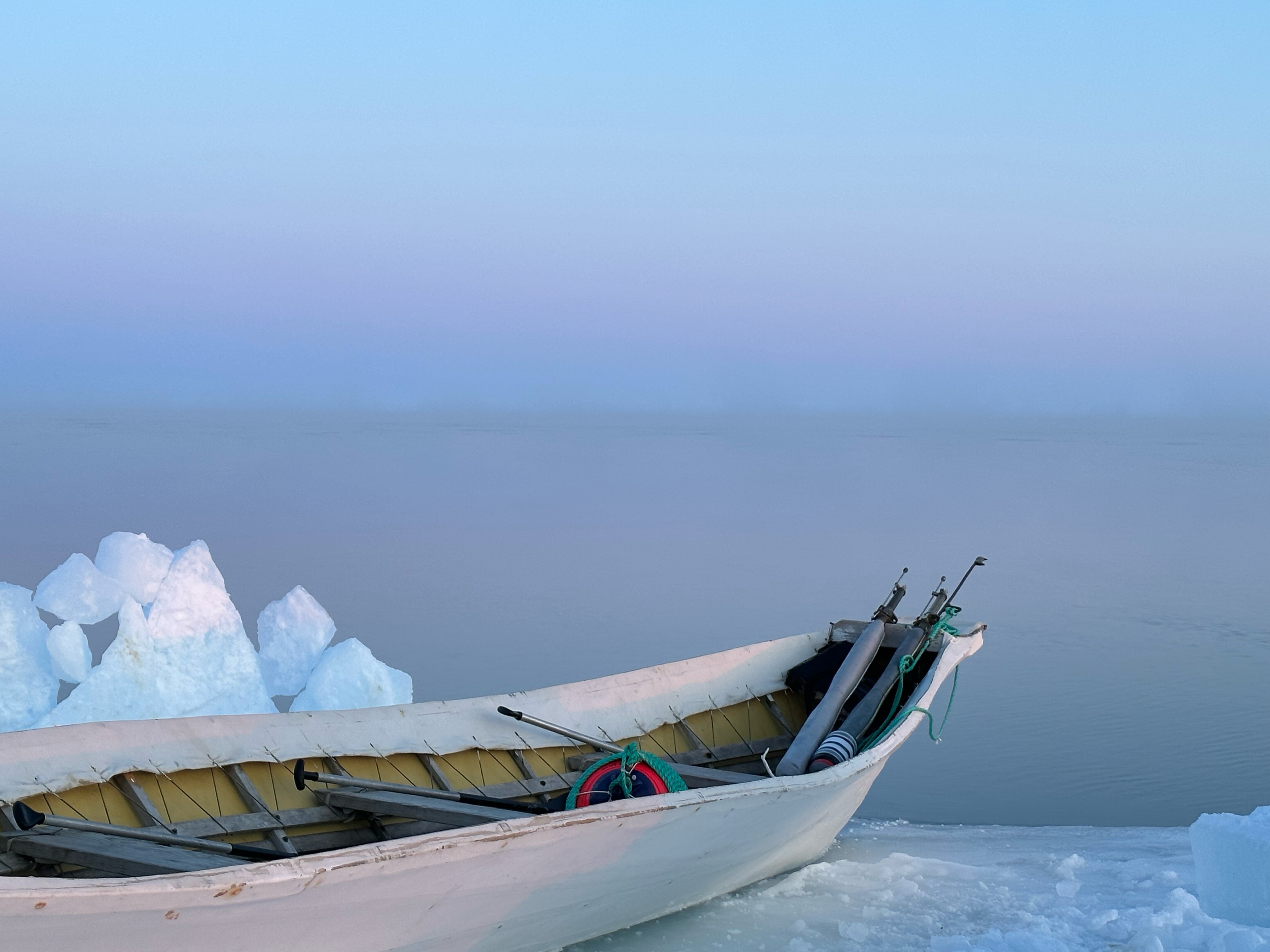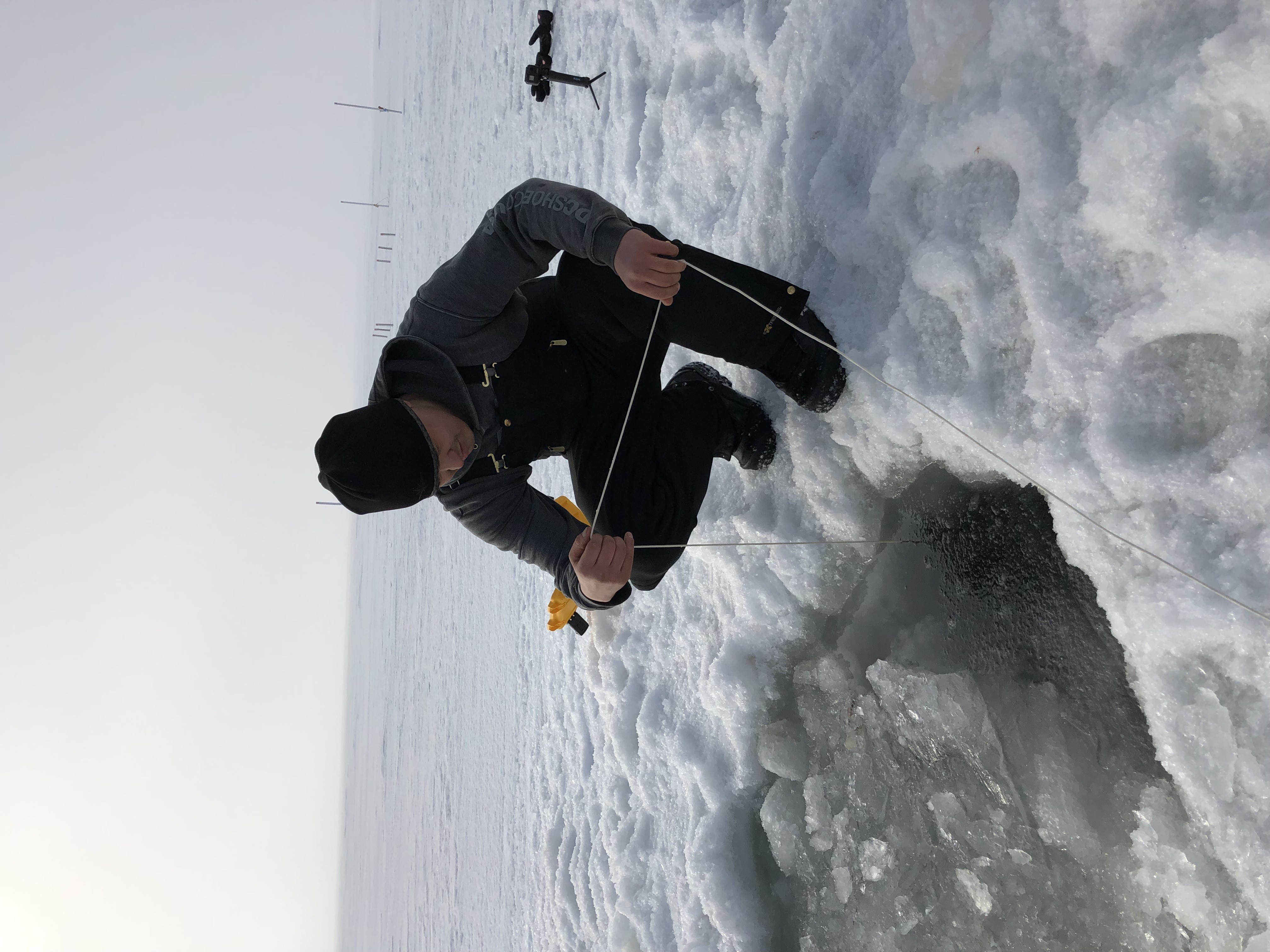Research elevates Arctic Indigenous voices to understand climate change
Kristin Summerlin
907-474-6284
July 25, 2023
Indigenous Alaskans have shared nearly 10,000 observations about the rapidly changing Arctic during the past decade in a partnership with university scientists presented in a recent paper.

An umiaq (boat) sits at the slushy ice edge of the Arctic Ocean near Point Hope, Alaska. A recent paper describes a long-running partnership between scientists and Indigenous Alaskans that taps into Indigenous knowledge to respond to the changing Arctic. Photo by Guy Omnik.
The paper, published in the journal Arctic Science, outlines results and lessons from the Alaska Arctic Observatory and Knowledge Hub, the largest and longest network of its kind. AAOKH is a network of Iñupiaq community observers from five northern Alaska communities collaborating with University of Alaska Fairbanks researchers at the International Arctic Research Center.
“We are working directly with the Indigenous people who have been monitoring and stewarding the Arctic environment since time immemorial,” said UAF research assistant professor Donna Hauser, the project’s lead scientist and the primary author of the paper. “We are trying to elevate and center Indigenous knowledge and perspectives in a way that most scientists have not historically.”
AAOKH began in 2016 to provide coastal Alaska’s Arctic communities with resources and scientific support to share local expertise on changing environmental conditions and their impacts. Guided by a steering group of Indigenous leaders and academic researchers, the research is designed with significant Indigenous input and focuses on questions relevant to their needs.
The backbone of the project is a collection of almost 10,000 unique environmental observations from community members. Critically, the reports include Indigenous knowledge and local perspectives.
“Our language was not written, so remembrance is important to what happened years before with the environment and how it affected our subsistence way of life,” said Robert Shaeffer, one of the observers. “I remember my father observing changes in our climate and environment and how they affected the animals and fish. As I grew older, I started noticing changes as well because he embedded into me being observant of the environment.”
Schaeffer, an Iñupiaq elder in Kotzebue, has been working with AAOKH for about three years. He worries about what kind of world his children, grandchildren and great-grandchildren will wake up to. He wants the world to know that his people are concerned.
“We’re living in ground zero,” said Schaeffer, who has also lobbied for climate action. “I try to encourage those that are doing studies worldwide, especially when it comes to global warming, that local voices be involved because we live it, we're experiencing it, and we all notice the changes.”

Community observer Vincent Schaeffer takes an oceanographic measurement.
Observers like Schaeffer create reports that include their own perspectives with environmental data.
An extreme lack of sea ice and record-breaking early thaw marked 2019 as an unusual year for Kotzebue. Observers collected data on water salinity, temperature and algal life for scientific research. Locals also explained the connection to natural resources, particularly bearded seals, their most important marine resource. An elder said 2019 was the earliest time he could remember going hunting, and Schaeffer said increased June water temperatures forced crabs to move to deeper waters in mid-July for the first time.
Hauser said such Indigenous knowledge has been underrepresented and even devalued in some cases. “It's really a long-term perspective, a holistic perspective that we can't get in science otherwise,” she added.
With eyes ahead, the project also provides opportunities for the next generation of Indigenous scholars. Three UAF graduate students from Indigenous Alaska communities were part of the project, including Roberta Tuurraq Glenn, a co-author on the recent paper who is now AAOKH’s project coordinator and community liaison.
Glenn, who is Iñupiaq from Utqiaġvik, created a multimedia story map to visualize environmental changes, how they affect communities and their cultural context. She said the research was built on the experience of people in her region, the North Slope.
“These aren't just reports, they are stories embedded with Indigenous knowledge,” Glenn said. “I wanted to put something together that reflects the changes they're seeing from their words, perspectives, and photos. From there, I gathered other scientific data to be able to complete that story.”
Glenn said the most important part was working with observers to confirm the information accurately reflected their perspective, which reflects AAOKH’s approach.
Both Glenn and Hauser said strong relationships, built on communication, respect and trust, are a critical part of the project. Without them, the world can’t understand how the people who are living through these changes are affected.
“They want people to know that climate change is happening, but it's maybe not quite how everyone is portraying it in the news,” Glenn said. “One of the big lessons I learned was from an observer, Billy Adams. He said ‘You need to include something positive. You need to tell people that we're still able to go out and harvest animals successfully. We're still here. We're still thriving. We are resilient people.’”
CONTACT: Donna Hauser, dhauser2@alaska.edu, 907-474-1553; or Roberta Glenn, rjglenn@alaska.edu
010-24


